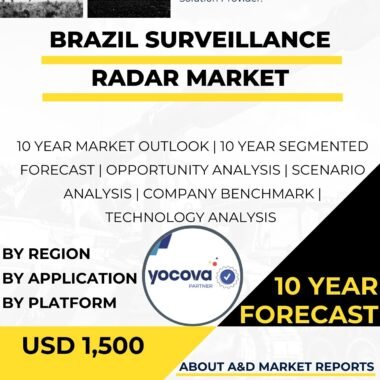Description
The Sweden Surveillance Radar Market holds significant strategic importance in the country’s defense industry, representing a critical component of its airspace surveillance, border security, and maritime domain awareness efforts. Surveillance radars are sophisticated technologies used for detecting and tracking airborne, ground, and maritime targets in various weather conditions. These advanced systems play a pivotal role in enhancing Sweden’s defense readiness, ensuring the safety of its airspace, and bolstering its ability to monitor and protect its territorial waters and national borders. Sweden’s commitment to innovation, technological expertise, and defense modernization has positioned it as a key player in the global Surveillance Radar Market.
The Sweden Surveillance Radar Market caters to diverse defense and security applications, each contributing to the nation’s overall situational awareness and operational effectiveness. One of the primary applications is in the field of air surveillance and air traffic management. Surveillance radars equipped with long-range detection capabilities and advanced tracking algorithms provide Sweden’s air defense forces and civil aviation authorities with a comprehensive picture of the country’s airspace, identifying and monitoring aircraft movements and potential threats.
Moreover, the market addresses surveillance radars’ role in ground-based surveillance. These radars are utilized for monitoring and securing Sweden’s land borders, detecting and tracking unauthorized border crossings, and supporting law enforcement and immigration control efforts.
Additionally, the Sweden Surveillance Radar Market caters to the domain of maritime surveillance. Coastal surveillance radars, as well as shipborne radars, play a crucial role in monitoring Sweden’s extensive territorial waters, detecting and tracking maritime vessels, and supporting search and rescue operations at sea.
Sweden’s defense industry actively engages in research and development (R&D) activities to advance surveillance radar technologies. Collaboration between the defense industry, research institutions, and the Swedish Armed Forces fosters innovation and technological advancements in the market. This synergy ensures that surveillance radars are equipped with cutting-edge antenna technology, signal processing algorithms, data fusion capabilities, and integrated command and control functionalities, tailored to meet specific defense requirements and optimized for Sweden’s defense needs.
Moreover, the market benefits from Sweden’s expertise in radar engineering and signal processing. Swedish companies have been at the forefront of developing state-of-the-art surveillance radar solutions, addressing the unique challenges of clutter rejection, target identification, and radar network integration.
The integration of emerging technologies has further enriched the capabilities of surveillance radars in Sweden. Advancements in digital beamforming, software-defined radar, and artificial intelligence enable surveillance radars to achieve improved target discrimination, enhanced tracking accuracy, and the ability to detect and counter emerging aerial threats, such as drones and low observable aircraft.
Furthermore, the export-oriented focus of the Sweden Surveillance Radar Market has expanded its global presence. Swedish surveillance radars have gained international recognition for their reliability, performance, and adherence to strict international arms export regulations. Sweden places a high priority on responsible arms trade, ensuring that its surveillance radar exports are subject to robust end-user controls and abide by international arms transfer agreements.
Despite the impressive progress and benefits of surveillance radars, challenges remain in the market. Ensuring the responsible and ethical use of surveillance radars is a critical consideration. Proper training, adherence to strict rules of engagement, and stringent control of surveillance radar distribution are essential to prevent their misuse and protect civilian privacy during surveillance operations.
Moreover, the market faces the challenge of addressing potential electronic countermeasures and stealth technologies. As adversaries develop advanced electronic warfare capabilities and low observable platforms, continuous investment in research and development is necessary to maintain the effectiveness and resilience of surveillance radars.
Looking ahead, the future of the Sweden Surveillance Radar Market remains promising, driven by continuous research and development efforts, international collaborations, and the increasing demand for advanced and adaptable surveillance technologies. As technology continues to evolve, Sweden’s dedication to innovation and technological prowess will solidify its position as a leading player in the global Surveillance Radar Market. The market’s ability to cater to diverse defense and security requirements while embracing technological advancements will ensure that Sweden’s surveillance radars remain at the forefront of modern surveillance capabilities, enhancing the nation’s defense readiness and contributing to global security efforts.




